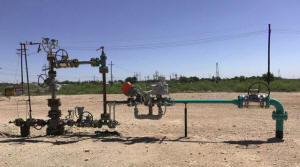|
Big oil, small U.S. towns see new reward
in old production technique
 Send a link to a friend
Send a link to a friend
 [June 05, 2017]
By Ernest Scheyder [June 05, 2017]
By Ernest Scheyder
HOBBS, New Mexico (Reuters) - Amid the
frenetic activity of American shale oilfields recovering from a two-year
recession sit a handful of oil towns that seemed impervious as many
producers went into bankruptcy and the economy around them sank.
Occidental Petroleum Corp and a few other oil producers with wells near
this town on New Mexico's border with Texas steadily pumped low-cost oil
through the downturn, using a technique that has been heralded worldwide
as a way to reduce carbon emissions and boost oil output.
"When everyone else in the oil industry was going down, Oxy kept
working," said Joshua Grassham, vice president of Lea County State Bank
and a Hobbs Chamber of Commerce board member. The city of 35,000 rests
on the Permian oilfield, the largest oilfield in the United States.
This way of drilling brings with it a sweetener for the oil industry to
keep crude flowing: a tax credit that helps insulate these wells in a
downturn, and could triple in size if Congress approves a new measure
this summer.
Such a move could extend by decades the producing life of hundreds more
wells, increasing oil supply which would be a drag on prices. To date,
the technique has been employed only at conventional oilfields, rather
than on shale deposits. Some firms are studying how to put the technique
to work in shale drilling, too.

The drilling method harnesses the carbon dioxide produced during the
extraction of oil or from power plants, and forces it back into the
fields. That boosts the pressure underground and drives more oil to the
surface.
Their success could be replicated in oilfields across the United States
if Congress approves the measure, which already enjoys broad bipartisan
support. While the Trump administration has yet to say whether it
supports the tax credit increase, the measure could also be a boon to
the coal industry, which Trump wants to revitalize.
The technique, one of several so-called enhanced oil recovery (EOR)
strategies used to prolong the productive lifespan of oilfields and
increase output, underpins around five percent of U.S. oil output, or
about 450,000 barrels per day, according to energy consultancy Advanced
Resources International.
EOR can help firms to produce between 30 percent and 60 percent of all
the oil held in a reservoir. That's far more than the 10 percent usually
recovered from initial traditional drilling, according to the Department
of Energy.
The existing credit has provided a financial lift for Occidental,
Denbury Resources Inc and oil producers with ready access to the gas.
Exxon Mobil Corp and Chevron Corp also use the technique on some of
their oil fields. None detail their tax savings from the credit, but
since the it was first offered in 2008, companies have collected at
least $350 million in the credits, according to Internal Revenue Service
figures.
In Hobbs, Occidental not only kept a 200-person workforce intact during
the oil-price downturn - when tens of thousands of workers were laid off
in the shale patch - it also invested $250 million to expand operations
during that period, according to its public filings.
That meant Hobbs and nearby Seminole, Texas, where Hess Corp has its own
carbon dioxide injection facility, didn't suffer the extreme financial
pain felt by shale towns, such as Williston, North Dakota, and other
shale producing communities in 2015 and 2016.

"Oxy's investment in the carbon project was a huge economic boost to our
area," Grassham said.
Some of the carbon dioxide, a greenhouse gas, comes from naturally
occurring reservoirs that are a low-cost source for Occidental. Others
get the gas piped from power plants that burn coal. Power companies hope
the technique can help them avoid higher carbon emissions.
The company spends about $18 to $25 per barrel to collect oil from its
enhanced oil recovery operations. In contrast, its shale-focused well
costs are lower - $16 to $19 per barrel. But because EOR wells pump
consistently for decades, their value to the company over time exceeds
shale wells, whose production quickly tapers off.
[to top of second column] |

A wellhead is seen at an Occidental Petroleum Corp carbon dioxide
enhanced oil recovery project in Hobbs, New Mexico, U.S. on May 3,
2017. Picture taken on May 3, 2017. REUTERS/Ernest Scheyder/File
Photo

Across Texas and New Mexico, Occidental runs one of the world's
largest fleet of enhanced oil recovery projects, injecting 2 billion
cubic feet of carbon dioxide each day into wells that first produced
oil nearly a century ago.
"We had a very large, stable carbon dioxide EOR business in our
portfolio during the downturn," said Jody Elliott, president of
Occidental's American operations. "That helped."
Partly because of its carbon facilities, Occidental was able to
raise its dividend during the downturn. Today, executives are using
the profits from the carbon business to grow its shale business
across the Permian, the largest acreage holding in the region.
"These two businesses play very well off of each other," Elliott
said.
TAX CHANGE?
Congress is expected this summer to debate extending an existing tax
credit that could pave way for wider use. The proposed Carbon
Capture Utilization and Storage Act would boost the credit to $35
per metric ton of carbon dioxide, up from $10 per ton today.
The legislation failed to move forward during last year's heated
presidential campaign, but supporters say it will be reintroduced
soon. "We want to make sure that we show a strong commitment so we
continue to develop these technologies," said North Dakota Senator
Heidi Heitkamp, a Democrat and the bill's lead sponsor.
Electricity generator NRG Energy Inc earlier this year opened a
$1.04 billion carbon capture facility at a Texas coal-fired power
plant, using its carbon dioxide emissions to extract crude from a
1930s-era oilfield.

Expanding the credit could, supporters hope, encourage more
coal-fired power plants to follow NRG's lead by capturing and
selling carbon to oil producers. Most oilfields are not located near
carbon dioxide supplies, so the tax credit also could spur the
build-out of carbon pipelines.
Environmentalists, including the Sierra Club, like the process
because it traps carbon underground, preventing it from contributing
to greenhouse gas emissions.
"You'll put more carbon in the ground than oil that is produced,"
said Vello Kuuskraa, president of consultancy Advanced Resources
International, which studies enhanced oil recovery and carbon
storage.
Oxy is considering investing another $550 million in its Hobbs
operation in the next several years to further expand its carbon
facilities.
"During all these oil industry downturns, those carbon wells keep
people working," said Grassham.
(Reporting by Ernest Scheyder; Additional reporting by Mike Wood and
by Timothy Gardner in Washington; Editing by Gary McWilliams, Simon
Webb and Edward Tobin)
[© 2017 Thomson Reuters. All rights
reserved.]
Copyright 2017 Reuters. All rights reserved. This material may not be published,
broadcast, rewritten or redistributed.

 |